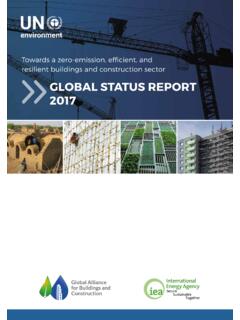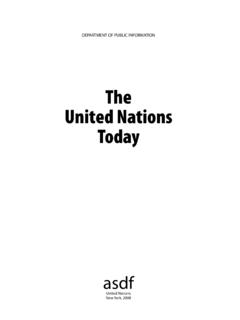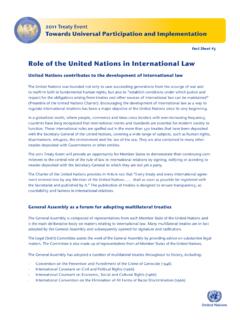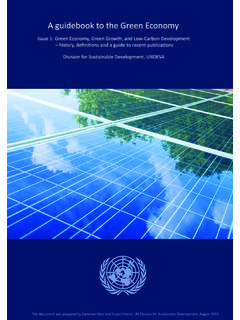Transcription of Global Status Report 2017 - World Green Building Council
1 Global Status Report 2017 Towards a zero-emission, efficient, and resilient buildings and construction sectorAcknowledgementsThe Global Status Report 2017 was prepared by Thibaut Abergel, Brian Dean and John Dulac of the International Energy Agency (IEA) for the Global Alliance for Buildings and Construction (GABC). The Report was coordinated by united nations environment Programme and was made possible by the generous support of the governments of France and Germany as well as the French environment and Energy Management Agency (ADEME).
2 The authors would like to thank the following persons for their important contributions, input, comments and review of the 2017 Global Status Report , including:Allen Ang Keppel Land Limited, SingaporeMiriam Badino ICLEI -Local Governments for SustainabilityManfred Braune Green Building Council South Africa (GBCSA)Victoria Burrows, Jonathan Laski, Audrey Nugent and Terri Wills World Green Building Council (WorldGBC) and Thulani Vuyo Kuzwayo WorldGBC Africa Regional NetworkTan Wang Cai and Sebastian Wang Sunseap Leasing Pte Ltd, SingaporeLaura Cozzi, Brian Motherway and David Turk International Energy Agency (IEA)
3 Anna Creed and Cory Nestor Climate Bonds InitiativeLuca De Giovanetti Sustainable Development Advisor Jamila El Harizi and Majida El Ouardirhi Ministry of National Planning, Urban Planning, Housing and City Policy (Minist re de l Am nagement du Territoire National, de l Urbanisme, de l Habitat et de la Politique de la Ville), Morocco Peter Graham Global Buildings Performance Network (GBPN)Thomas Gu ret, R gis Meyer and Yves Laurent Sapoval Ministry of Ecological and Inclusive Transition (Minist re de la Transition cologique et Solidaire), FranceUrsula Hartenberger Royal Institution of Chartered Surveyors (RICS)Pekka Huovila - The 10 YFP Programme on Sustainable Buildings and ConstructionBenoit Lebot International Partnership for Energy Efficiency Cooperation (IPEEC)Eric Mackres World Resources Institute (WRI)Rusmir Musi International Finance Corporation (IFC)
4 Martina Otto and Nora Steurer united nations environment ProgrammeOliver Rapf and Max Ramezani Buildings Performance Institute Europe (BPIE)Cecilia Rinaudo La Voute NubienneKyryl Tomliak Advisor, State Agency for Energy Efficiency and Energy Saving of UkraineRyan Jin Zhanha Nanyang Technological University, SingaporeVictor Zu iga Ministry of Energy (Secretar a de Energ a), MexicoCover Images: La Voute Nubienne, iStock, Shutterstock, John DulacCopyright united nations environment Programme, 2017 This publication may be reproduced in whole or in part and in any form for educational or non-profit purposes without special permission from the copyright holder, provided acknowledgement of the source is made.
5 The united nations environment Programme would appreciate receiving a copy of any publication that uses this publication as a use of this publication may be made for resale or for any other commercial purpose whatsoever without prior permission in writing from the united nations environment electronic copy of this Report can be downloaded at Citation: UN environment and International Energy Agency (2017): Towards a zero-emission, efficient, and resilient buildings and construction sector. Global Status Report views expressed in this Global Status Report 2017 are not necessarily those of the GABC partners.
6 The designations employed and the presentation of the material in this publication do not imply the expression of any opinion whatsoever on the part of the authors, the united nations environment Programme or the International Energy Agency concerning the legal Status of any country, territory, city or area, nor of its authorities, nor concerning the delimitation of its frontiers or boundaries. Moreover, the views expressed do not necessarily represent the decision of the stated policy of the united nations environment Programme or International Energy Agency, nor does citing of trade names or commercial process constitute No.
7 : 978-92-807-3686-1 Job No.: DTI/2151/PAUNEP 188 Geographical disclaimerThe designations employed and the presentation of material in this publication do not imply the expression of any opinion whatsoever on the part of the united nations environment Programme or the International Energy Agency concerning the legal Status of any country, territory or city or its authorities, or concerning the delimitation of its frontiers or environment promotes environmentally sound practices globally and in its own activities.
8 This publication is printed on 100% recycled paper, using vegetable - based inks and other eco-friendly practices. Our distribution policy aims to reduce UN environment 's carbon environment &Energy Management AgencyGLOBAL Status Report 2017 Towards a zero-emission, efficient, and resilient buildings and construction sectorGLOBAL Status Report 20172 PrefaceThe Global buildings sector is growing at unprecedented rates, and it will continue to do so. Over the next 40 years, the World is expected to build 230 billion square metres in new construction adding the equivalent of Paris to the planet every single week.
9 This rapid growth is not without consequences. While buildings sector energy intensity has improved in recent years, this has not been enough to offset rising energy demand. Buildings-related CO2 emissions have continued to rise by around 1% per year since 2010, and more than four million deaths each year are attributable to illness from household air , many opportunities exist to deploy energy-efficient and low-carbon solutions for buildings and construction. These solutions will necessitate greater effort to implement strategic policies and market incentives that change the pace and scale of actions in the Global buildings year s Global Status Report looks at the state of Global buildings and construction since the historic Paris Agreement at the 21st Conference of Parties.
10 It considers the numerous commitments and actions by countries, cities, industry and related stakeholders to help put the Global buildings and construction sector on a sustainable Report makes clear that while Global progress is advancing, there is a growing urgency to address energy demand and emissions from buildings and construction. Current policies and investments fall short of what is needed, and what is possible. Ambitious action is needed without delay to avoid locking in long-lived, inefficient buildings assets for decades to come.













